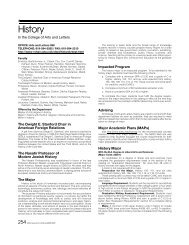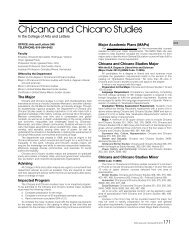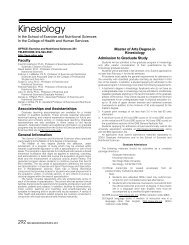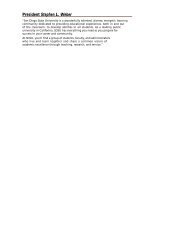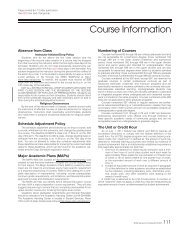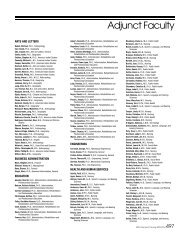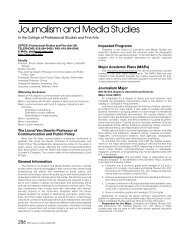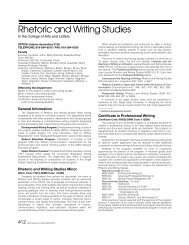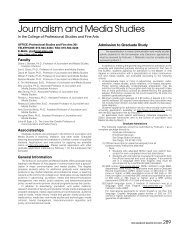President Stephen L. Weber - San Diego State University ...
President Stephen L. Weber - San Diego State University ...
President Stephen L. Weber - San Diego State University ...
Create successful ePaper yourself
Turn your PDF publications into a flip-book with our unique Google optimized e-Paper software.
Communicative Disorders<br />
Liability Insurance<br />
Students enrolled in Communicative Disorders 340L, 357,<br />
525, 526, 541, 545, 546, 556, 626, 627, 645, 646, 656,<br />
676, 933, 953 are required to purchase professional liability<br />
insurance.<br />
Early Intervention Certificate<br />
The Early Intervention Certificate is designed to prepare<br />
speech-language pathologists to work with infants, toddlers, preschoolers,<br />
and their families. The certificate program is appropriate<br />
for graduate students in communicative disorders who wish<br />
to specialize in early intervention practice. The number of persons<br />
admitted to the program each year may be limited.<br />
Candidates for the certificate must be enrolled in or have<br />
completed the communicative disorders graduate degree program<br />
with a concentration in speech-language pathology. To be<br />
admitted into the certificate program and to be eligible for a certificate<br />
of completion, the student must obtain an approved plan<br />
of study from the department’s Early Intervention Certificate<br />
coordinator and apply to the Graduate Division. Upon completion<br />
of requirements for the certificate program, the student must<br />
submit to the Graduate Division a certificate completion form<br />
signed by the department chair.<br />
The certificate program requires completion of 14 units,<br />
including 10 units of substantive coursework, one unit of independent<br />
study (CDIS 798) to obtain preclinic observation hours<br />
(25 hours), and three units of clinic courses (75 hours of patient<br />
contact). The practica hours obtained for the Early Intervention<br />
Certificate are applicable to the minimum needed for professional<br />
licensure and national certification.<br />
CDIS 650 Interdisciplinary Field Education Seminar (1)<br />
CFD 570 Infant/Toddler Development (3)<br />
SPED 528 Early Intervention for Infants and Young Children<br />
with Disabilities and Their Families (3)<br />
Elective selected from 600-700 level courses with approval<br />
from Certificate Coordinator (3)<br />
CDIS 798 Observations of Speech-Language Pathologists<br />
Working with Infants, Toddlers, and Preschoolers (1)<br />
CDIS 521/526/626 or 619/627 (3) Clinic courses providing<br />
75 hours of practica with infants, toddlers, and preschoolers.<br />
The clinic courses require eligibility for clinic and approval by<br />
the Clinic Director of Speech-Language Pathology similar to all<br />
clinic assignments. The student must meet with the Clinic Director<br />
of Speech-Language Pathology to work out clinic assignments<br />
appropriate for the Early Intervention Certificate. With<br />
approval of the graduate adviser, a student may apply up to three<br />
units of communicative disorders coursework from the certificate<br />
program toward a master’s degree in communicative disorders.<br />
Professional Services<br />
Bilingual/Multicultural Certificate<br />
The Professional Services Bilingual/Multicultural Certificate in<br />
Communicative Disorders is designed primarily for persons who<br />
plan to work with bilingual populations with communicative<br />
disorders.<br />
112<br />
To be a candidate for the certificate, the student must be<br />
actively seeking or have completed a credential or degree program<br />
in communicative disorders since the certificate is coordinated<br />
with these endeavors. Candidates seeking admission to the<br />
certificate program must present acceptable GRE scores and<br />
schedule an interview with the departmental certificate coordinator<br />
to ascertain specific requirements and units. They must demonstrate<br />
a proficiency in two languages (English and one other)<br />
and satisfy admission requirements of the <strong>University</strong> and the<br />
department as listed in the Graduate Bulletin. The certificate is<br />
limited to those languages for which there is an available clinical<br />
population. Consult the certificate coordinator for approved<br />
languages.<br />
The certificate program requires completion of 13 units<br />
including nine units of substantive coursework and four units of<br />
graduate practicum with the targeted bilingual/multicultural population.<br />
The certificate is competency based and up to three units<br />
of specific requirements may be waived upon demonstration of<br />
competency. Course requirements include Communicative Disorders<br />
671, 672, and 673. Audiology and Deaf Education students<br />
may take Communicative Disorders 668 in lieu of any of the<br />
required courses. Students interested in a target language other<br />
than Spanish or English may select Communicative Disorders<br />
668 or 798 with permission from the certificate coordinator.<br />
With the approval of the department, a student may apply no<br />
more than three units of coursework from the certificate program<br />
toward a master’s degree.<br />
Courses Acceptable on Master’s and<br />
Doctoral Degree Programs in the<br />
Department of Communicative Disorders<br />
(C DIS)<br />
UPPER DIVISION COURSES<br />
501. Voice Disorders: Children (3)<br />
Two lectures and three hours of laboratory.<br />
Prerequisite: Communicative Disorders 321.<br />
Theory and practice in the remediation of voice disorders.<br />
Laboratory involves measurements of vocal dimensions and perceptual<br />
training for diagnosis and remediation of voice disorders.<br />
505. Remediation for Fluency Disorders in School-Aged<br />
Children (3)<br />
Prerequisite: Communicative Disorders 322.<br />
Theoretical and phenomenological understanding of stuttering<br />
as a communicative disorder; explanations for learning of<br />
dysfluent behaviors; applied techniques in rehabilitation for<br />
school-aged children with dysfluent speech.<br />
511. Pediatric Aural Rehabilitation (3)<br />
Prerequisites: Communicative Disorders 320, 323, and 340.<br />
Recommended: Communicative Disorders 300, 357, and 513.<br />
Theoretical, methodological, and technical issues related to<br />
facilitating receptive and expressive communication in individuals<br />
who are deaf or hard-of-hearing. Emphasizes multidisciplinary<br />
case management of children.



